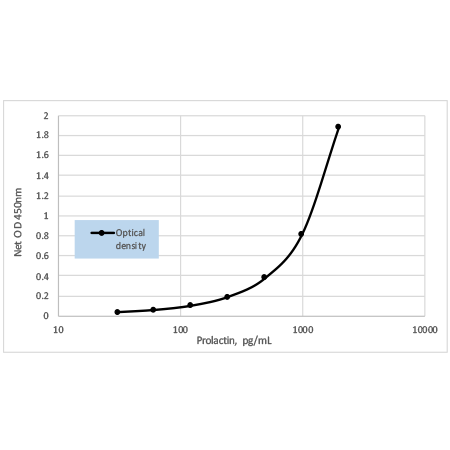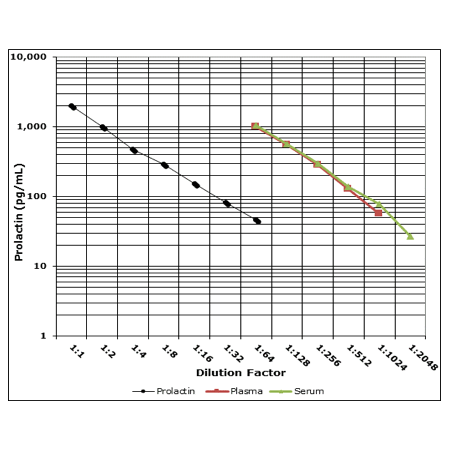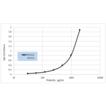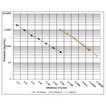- High-sensitivity ELISA enables quantification of low amounts of Prolactin
- Rapid quantitative results in 3 hours
- High-throughput immunoassay measures up to 38 samples in duplicate per 96 well kit
- Ready-to-use reagents and pre-coated plates reduce errors and save time
The Prolactin ELISA kit is a colorimetric immunoassay kit with results in 3 hours. Absorbance is read at 450 nm. Measure up to 38 samples in duplicate per 96 well kit.

Standard curve for Prolactin ELISA Kit (ENZ-KIT161).

Parallelism graph displaying dilutional linearity for Prolactin ELISA kit (ENZ-KIT161).
Please mouse over
Product Details
| Alternative Name: | Luteotropic hormone, Luteotropin |
| |
| Sensitivity: | 19.2 pg/mL (31.3 - 2000 pg/mL) |
| |
| Assay Time: | 3 hours |
| |
| Applications: | ELISA, Colorimetric detection
|
| |
| Application Notes: | For the quantitative determination of human Prolactin in serum and plasma. |
| |
| Wavelength: | 450 nm |
| |
| Species reactivity: | Human
|
| |
| Crossreactivity: | Negligible crossreactivity to LH, FSH, TSH, HGH, and HCG |
| |
| Use/Stability: | Store all components at -20°C. |
| |
| Shipping: | Blue Ice |
| |
| Contents: | Prolactin microtiter plate, Assay Buffer, Prolactin Conjugate, Prolactin Antibody, Prolactin Standard, Wash Buffer, TMB Substrate, Stop Solution, Assay Layout Sheet, Plate Sealer |
| |
| Scientific Background: | Prolactin, also known as luteotropic hormone or luteotropin, is best known for its role in enabling mammals (usually female) to produce milk. Specifically, prolactin is the hormone primarily responsible for the synthesis of milk protein, lactose and lipids, all major components of milk. Prolactin is secreted from the pituitary gland in response to eating, mating, estrogen treatment, ovulation and nursing. Prolactin plays an important role in metabolism, regulation of the immune system and pancreatic development. Prolactin and the prolactin receptor are expressed in ovarian and fallopian tube tissues and are involved in physiological ovarian processes, such as follicle development and corpus luteum function, during the menstrual cycle and pregnancy. During pregnancy there is a steady five-to-tenfold rise in plasma prolactin levels and the stimulating action of prolactin on the mammary gland leads to post-partum lactation. This is thought to be the main role for prolactin during pregnancy. Prolactin is 199 amino acids in length and occurs in both glycosylated and non-glycosylated forms. It can be present in three different forms: monomeric or “little” prolactin, dimeric or “big” prolactin and “big-big” prolactin and these forms are 22, 48 and 150kDa in size, respectively. It is influential in over 300 separate processes and, in addition to pregnancy and lactation, has elevated levels during exercise, sleep, stress and depression. Prolactin also plays a role in systemic disorders such as chronic renal failure, cirrhosis, epileptic seizures, polycystic ovarian disease, and herpes zoster, among others. |
| |
| UniProt ID: | P05231 |
| |
| Regulatory Status: | RUO - Research Use Only |
| |
| Compatibility: | This product is compatible with the Absorbance 96 Plate Reader.
 |
| |
Related Products

















